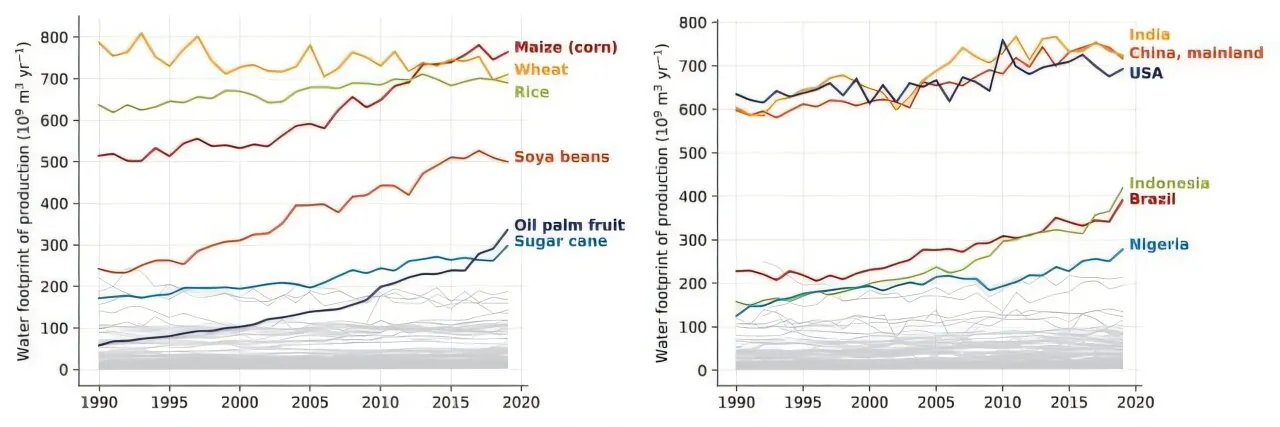
Nearly Seven Trillion Cubic Meters of Water Consumed Annually for Global Crop Production: Shocking Study Highlights Environmental Risks
2024-10-28
Author: Arjun
A groundbreaking study from researchers at the University of Texas (UT) has revealed alarming insights into the staggering amounts of water humanity consumes globally to cultivate essential crops. Published in the journal *Environmental Research Letters*, this extensive analysis examines water usage trends across 175 different crops from 1990 to 2019, illuminating the growing water crisis tied to agriculture.
Despite technological advancements leading to greater crop water productivity—whereby nearly 80% of the analyzed crops required significantly less water per ton by 2019 compared to 1990—the overall water consumption in agriculture has surged. Since 1990, the total water footprint of crop production has skyrocketed by nearly 30%, amounting to an estimated 6.8 trillion cubic meters annually. To put that in perspective, that equates to around 2,400 liters per person per day, a staggering figure considering global population growth.
What’s Causing This Increase?
A significant portion—nearly 90%—of this water footprint increase took place between 2000 and 2019. Researchers attribute this rise to three major socio-economic factors:
1. **Globalization and Economic Growth**: There's been an intensified demand for imported crops, pushing water consumption to new heights.
2. **Dietary Shifts**: People worldwide are increasingly turning to water-intensive food products, including meat and processed foods, which drastically inflate water requirements.
3. **Biofuel Boom**: Many governments’ pushes for energy security and green initiatives have ramped up the production of crop-based biofuels, further straining water resources.
The analysis highlights the rapid proliferation of so-called "flex crops," versatile crops that serve multiple ends (food, animal feed, biofuels, etc.). These crops, backed by strong agricultural lobbying, have proliferated over the years. Notably, just three crops—oil palm fruit, soybeans, and maize—account for roughly half of the total increase in the global water footprint for crop production between 1990 and 2019.
Regions of Concern
The study identifies India, China, and the United States as the largest consumers of agricultural water. However, the most significant increase in water usage occurred primarily across tropical regions, which are concurrently facing severe environmental issues like deforestation and biodiversity loss. The fertile conditions in these areas, coupled with favorable agricultural policies, have attracted considerable investment from major agrifood corporations. Consequently, certain regions have become dangerously specialized in a limited range of water-intensive crops.
Future Outlook: Can We Reverse the Trend?
Oleksandr Mialyk, the study's lead researcher, warns that unless significant changes are made, water consumption for crop production will continue to rise over the coming decades. The pressure on already stressed water resources could lead to dire consequences for both ecosystems and human populations.
However, there is room for optimism. The researchers contend that enhancing crop water productivity, shifting agricultural production to areas with less water scarcity, and encouraging widespread adoption of water-efficient diets could play crucial roles in mitigating this crisis. Additionally, minimizing reliance on first-generation biofuels could further alleviate the demand for water-intensive crop production.
The time for action is now. As Mialyk emphasizes, “Our research has highlighted pressing problems; it's time to actively pursue solutions for a more water-sustainable future in agriculture.” With collective efforts from governments, industries, and consumers, we have the potential to turn the tide on this growing water crisis.
Make sure to stay informed—this issue impacts us all!


 Brasil (PT)
Brasil (PT)
 Canada (EN)
Canada (EN)
 Chile (ES)
Chile (ES)
 España (ES)
España (ES)
 France (FR)
France (FR)
 Hong Kong (EN)
Hong Kong (EN)
 Italia (IT)
Italia (IT)
 日本 (JA)
日本 (JA)
 Magyarország (HU)
Magyarország (HU)
 Norge (NO)
Norge (NO)
 Polska (PL)
Polska (PL)
 Schweiz (DE)
Schweiz (DE)
 Singapore (EN)
Singapore (EN)
 Sverige (SV)
Sverige (SV)
 Suomi (FI)
Suomi (FI)
 Türkiye (TR)
Türkiye (TR)